Period of the American Art Colonies
American painters of the late 1800s and early 1900s returned from their studies in Europe to establish professional careers throughout the United States. These highly trained artists established art colonies that mirrored their experiences in Europe, where retreats at such places as Barbizon and Giverny, France, provided spaces for plein-air painting, away from the urban sprawl of cities. These new vacation spots in America, made accessible by rail travel and, later, automobiles, also attracted an art-buying tourist trade. Early notable art colonies included Shinecock Colony, Long Island, established by William Merritt Chase, and the art colony at Old Lyme, Connecticut. Delaware’s two notable art colonies included Arden in the north and Rehoboth Beach in the south. There were many colonies in surrounding states, as well, including those in New Hope and Rose Valley, Pennsylvania, and Easton, Maryland.
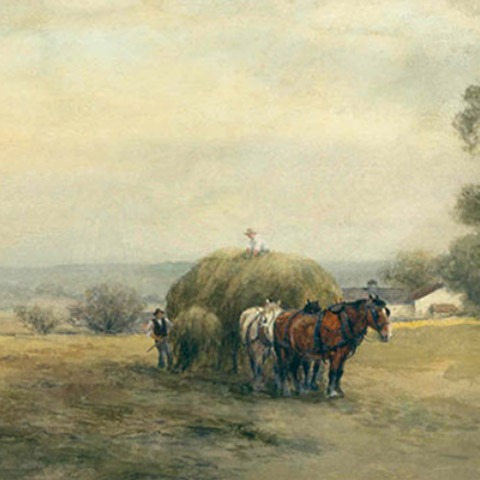
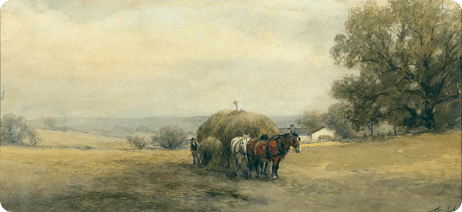
Frank English was an early resident of the northern Delaware art colony of Arden. He had already moved to nearby Claymont several years before Arden’s founding in 1900, preferring the rural scenery of the Delaware Valley. A native of Kentucky, English attended the Pennsylvania Academy of the Fine Arts and exhibited widely, including competitions at the Art Club of Philadelphia, the American Water Color Society, The Plastic Club, the Art Institute of Chicago, and the Pan-Pacific International Exposition in California. The artist moved to another art colony, Bucks County, in 1910, where he remained until his death in 1922.
LOADING HAY
FRANK ENGLISH (1854–1922)
CA. 1910
WATERCOLOR AND GOUACHE ON PAPER
GIFT OF SEWELL C. BIGGS; 1992.10
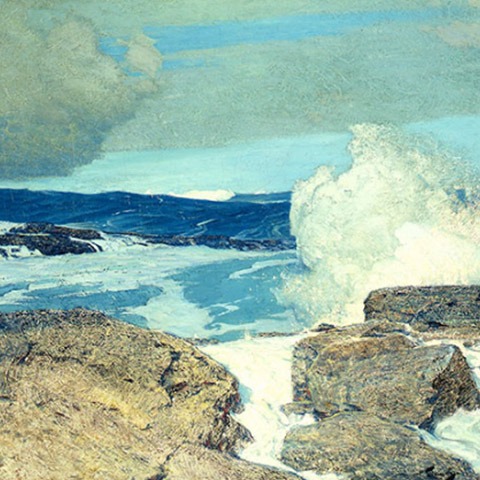
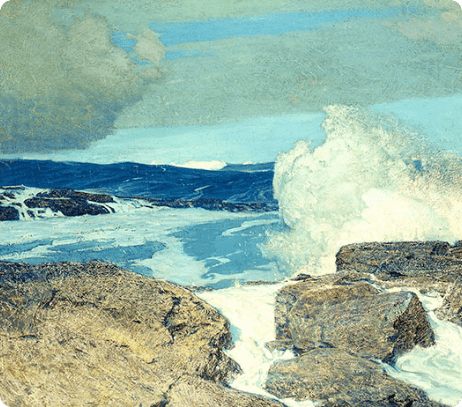
After finishing his studies at the Pennsylvania Academy of the Fine Arts in Philadelphia, Frederick Judd Waugh traveled several times to Europe, eventually relocating to the English coast, where he remained for more than fifteen years. Upon his return to the United States, the artist settled in the art colony of Provincetown, Massachusetts, closer to his preferred subject matter of rocky coastlines and marine scenery. Heavy Surf, which is probably an image of the Maine coast, won the Boston Art Club’s Walter M. Brackett Prize and the Connecticut Academy Prize.
HEAVY SURF
FREDERICK JUDD WAUGH (1861–1940)
1915
OIL ON CANVAS
SEWELL C. BIGGS BEQUEST; 2004.407
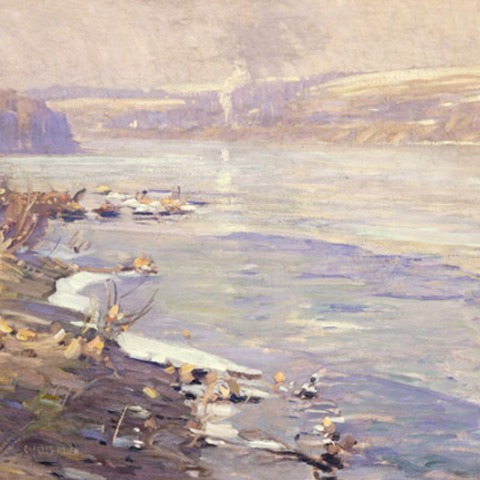
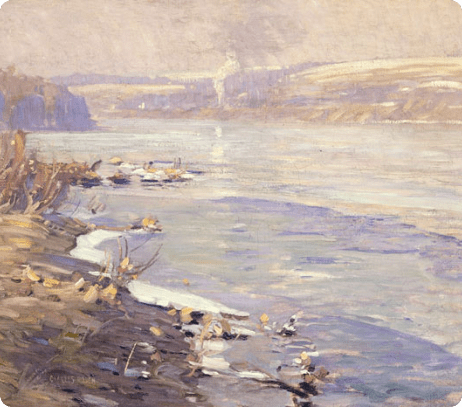
Charles Rosen was among the first American artists to settle outside New Hope in Bucks County, Pennsylvania. Like his contemporaries, Rosen painted from life, or plein-air, even in the cold of winter. His work during this time often depicts the Delaware River near his home. Later, the artist moved to another artist colony, Woodstock, New York.
DELAWARE RIVER NEAR NEW HOPE
CHARLES ROSEN (1878–1950)
CA. 1910–15
OIL ON CANVAS
GIFT OF SEWELL C. BIGGS; 1996.13
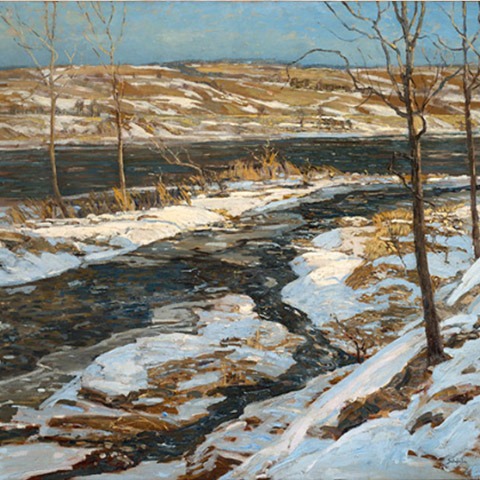
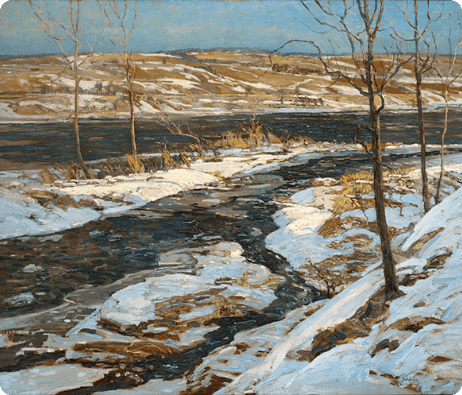
Although Walter Elmer Schoefield never lived in the art colony of Bucks County, Pennsylvania, he is associated with the Pennsylvania impressionist movement that emanated from this region. Like his better-known contemporary Edward Redfield (1869–1965), Schoefield perpetuated the rugged, romantic image of regional impressionist painters by working outdoors on enormous canvases in the coldest and most inhospitable environments.
SPRING THAW
WALTER ELMER SCHOEFIELD (1867–1944)
CA. 1913
OIL ON CANVAS
GIFT OF SEWELL C. BIGGS; 1996.15
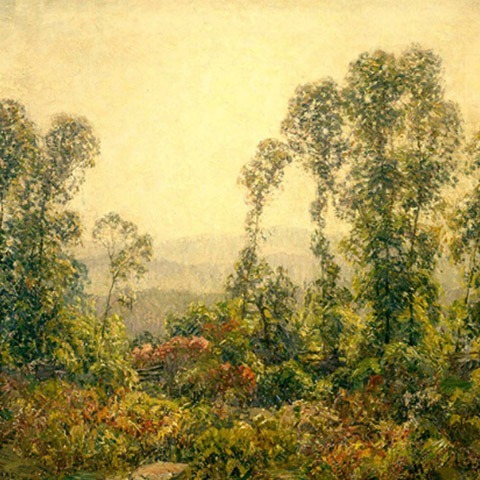
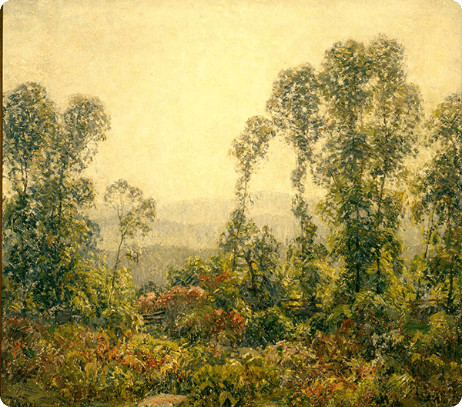
Wilson Henry Irvine received his initial art instruction from the Art Institute of Chicago. Although he settled in Connecticut, he traveled extensively through the United States and Western Europe to paint a variety of impressionistic landscapes. Irvine is closely associated with the artist colony in Old Lyme, Connecticut, which attracted many early impressionist painters in America.
THE PROCESSIONAL
WILSON HENRY IRVINE (1869–1936)
CA. 1920
OIL ON CANVAS
GIFT OF SEWELL C. BIGGS; 1996.8
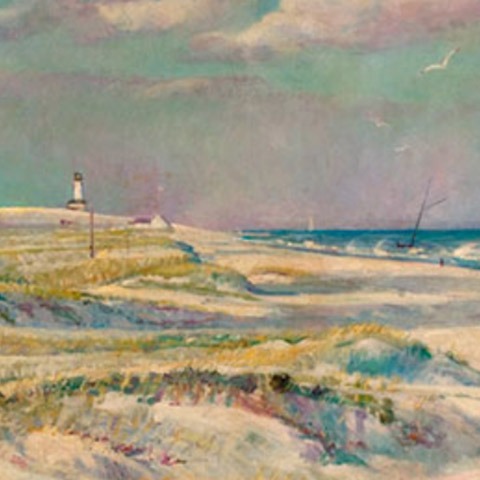
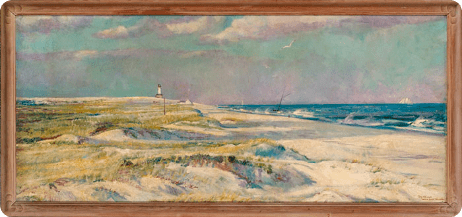
Described as the “dean of Delaware painters,” Ethel Leach was a founding member of the Rehoboth Art League, the center of the artist colony in Southern Delaware. Leach was a life-long resident of Frederica, Delaware, which she depicted often in her work. She studied illustration with Howard Pyle (1853–1911) and at the Académie Moderne in Paris, and kept a cottage at Rehoboth Beach with her husband, fellow painter William Leach. There they painted pictures for tourists and local patrons, depicting the pine forest, dunes, shipwrecks, and Henlopen Lighthouse before it fell into the sea in 1926.
FAR VIEW (THE OLD BEACH)
ETHEL PENNEWILL BROWN LEACH (1878–1959)
PRE-1926
OIL ON CANVAS
MUSEUM PURCHASE; 2010.6
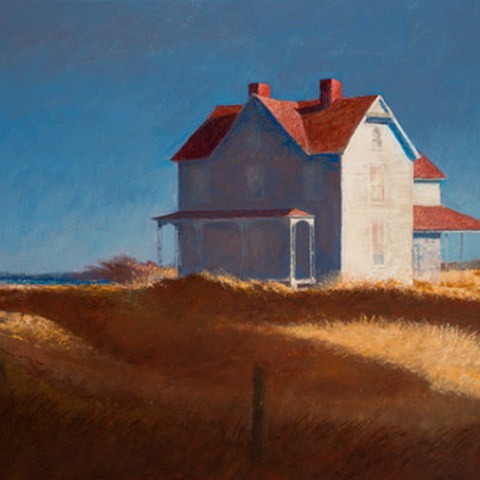
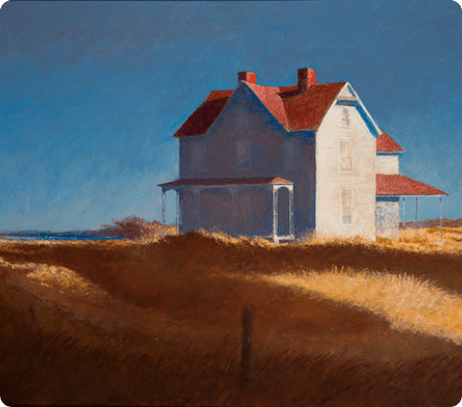
Edward Grant began his early art education at Wilmington Academy of Art alongside painter and philanthropist Henryette Stadelman Whiteside (1891–1973). Perhaps through Whiteside’s support, Grant studied art with N. C. Wyeth (1882–1945) and his contemporary, Andrew Wyeth (1917–2009). During the Depression, Grant modeled for and studied with illustrator Frank Schoonover (1877–1972) while also working on local mural commissions. He later became the artistic director of Hercules, Inc. After retiring to Neavitt, Maryland, Grant became involved with the artist community centered at The Academy in Easton.
UNTITLED (VANISHING POINT)
EDWARD GRANT (1907–1998)
DATE UNKNOWN
OIL ON BOARD
ON LONG-TERM LOAN COURTESY OF ALEX AND ALICIA GRANT


Don Stephens was the son of Frank Stephens, a co-founder of the utopian society of Arden, Delaware. This sideboard is part of a mission-style dining-room set Stephens made as a wedding gift to his brother Roger. This Arden sideboard sports iron hardware made at the Arden Forge, one of several craft industries created during the early years of the artist community. Other early industries included weaving, clothing design, silversmithing, and ceramics.
SIDEBOARD
DON STEPHENS (1887–1971)
1914
OAK, IRON
GIFT OF THE ESTATE OF CAROLINE
STEPHENS HOLT, 2011.1.1


The design of this so-called “Craftsman’s” chair is inspired by British Arts and Crafts Movement examples. Don Stephens joined this chair with wooden pins and carved its decoration by hand to express his preference against machine-made furniture of the Industrial Revolution. The chair is very similar to examples designed by William Lightfoot Price (1861–1916) in the nearby artist community of Rose Valley, Pennsylvania. Price and Don Stephens’s father founded Delaware’s northern artist colony of Arden in 1900.
CRAFTSMAN’S CHAIR
DON STEPHENS (1887–1971)
ARDEN, DELAWARE, CA. 1910
OAK
GIFT OF THE ESTATE OF CAROLINE STEPHENS HOLT
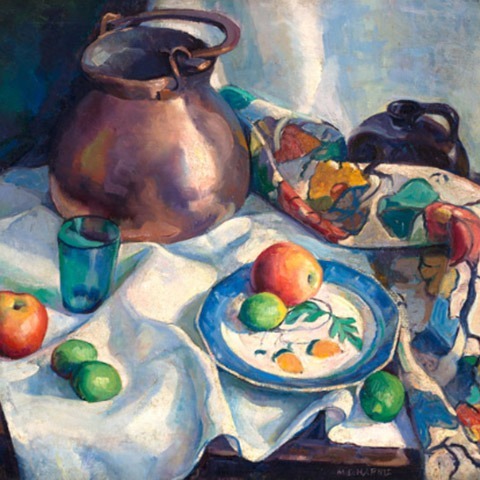
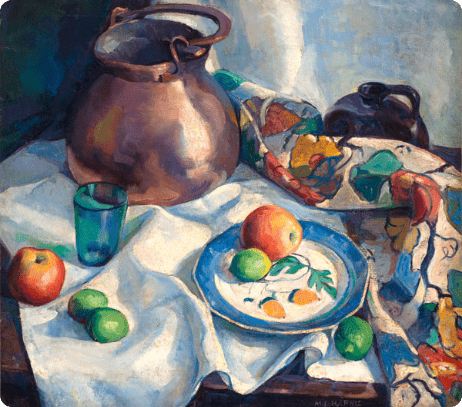
Marion D. Harris was an important figure in the Wilmington Academy of Art and acted as a teacher there intermittently from 1927-1937. Harris’ work often features highly saturated colors and bright light sources, offering an alternative to many of the active artists in Wilmington of the previous generation who preferred more subdued tones. Since the Biggs is one of the few museums that focuses on artists associated with art schools in the Delaware region, acquiring work by teachers like Harris helps the Biggs reach its goal in this area of the museum’s collecting mission.
FOR FURTHER THINKING: Marion Harris signed this work in the lower left corner and craftily painted the signature as if it were a carving in the table. If you were going to disguise your signature in a painting, how would you do it?

